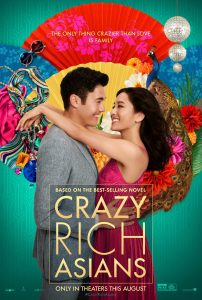Stamford Advocate
September 5, 2018
 The film “Crazy Rich Asians” has received attention in the media in recent weeks. One of the reasons is that this is the first major studio film with an Asian and Asian American cast since “The Joy Luck Club” in 1993.
The film “Crazy Rich Asians” has received attention in the media in recent weeks. One of the reasons is that this is the first major studio film with an Asian and Asian American cast since “The Joy Luck Club” in 1993.
The public can judge generalizations about a population based upon a movie in different ways. The American public currently has certain perceptions about Asian Americans — that they are all good in math, were responsible for introducing sushi to the masses, that they attend elite universities, and are affluent and successful. However, there has been a conceptual framework that has characterized Asian Americans unfairly and with racist overtones for many years — The Model Minority Myth.
In her book, “The Color of Success: Asian Americans and the Origins of the Model Minority,” Ellen Wu articulates the social, cultural, political and economic forces that have shaped the Model Minority Myth. Asian American scholars have addressed the concept of the Model Minority Myth since the 1960s. Many have steadfastly labored to defy its premises and implications. The consensus is that the model minority distorts the material realities and obscures the class diversity of a population that includes substantial numbers of poor and working-class people. Select Asian ethnic groups, such as Hmong and other Southeast Asian refugee communities in Connecticut, experience disproportionately high rates of welfare dependency and unemployment alongside disproportionately low levels of income and education.
More generally, working-class individuals comprise a significant portion of immigration from Asia, both documented and the 1.7 million Asian undocumented immigrants in the United States. To put those numbers in perspective, they account for about 16 percent or one out of every six undocumented immigrants in the United States and it also means that about one out of every seven Asian immigrants are undocumented. Thus, by being grouped together with more affluent Asian Americans, these segments of the Asian American population are often rendered invisible, and denied access to social welfare and other assistance opportunities.
In addition, the statistics invoked to support the model minority myth are misleading. While Asian Americans ostensibly boost the highest median income of any racial group, Asian American families generally include more workers per household than white families. Asian Americans also tend to concentrate in dense metropolitan areas where costs of living are well above the national average. Moreover, while certain Asian ethnic groups have completed more years of schooling than other races, Asian Americans as a whole earn less than whites of comparable educational levels. Despite perceptions to the contrary, Asian Americans are not above the dominant society’s biases and discrimination.
Take the most recent revelation that Harvard University was using a subjective scale to determine undergraduate admissions decisions. Specifically, the evaluation of the admissions process by the Department of Justice indicated that Asian Americans, who had higher GPAs and SAT scores than whites, were judged to have “social inadequacies” and “introverted personalities” that potentially would impede success at Harvard, and were subsequently passed over by whites with lower GPAs and SAT scores for admission at the university.
Furthermore, in November 2005, the Committee of 100, a national Chinese American Leadership Organization, chose to examine executive leadership in higher education among Asian Pacific Americans (APAs). The study concluded that while APAs are the most widely represented minority group within faculty ranks, the lack of APAs serving as presidents, vice presidents, and executive management positions demonstrates that APAs are “egregiously under-represented in executive decision-making roles.” There has been little progress toward addressing this leadership gap in higher education institutions
The current political bipolarization in America is a breeding ground for stereotypes and “fake news” to be perpetuated. This groundbreaking movie highlights the range of personalities that exemplify the Asian American population. The viewers, however, must understand that the Model Minority Myth continues to persist in American society.
Michael M. Ego teaches the course Asian Pacific American Families at the University of Connecticut, Stamford.
 TOKYO — Denny Tamaki, the son of a Japanese mother and a United States Marine, became the first mixed-race governor in Japan on Sunday after winning a close election in Okinawa, a southern archipelago heavily populated by American military installations.
TOKYO — Denny Tamaki, the son of a Japanese mother and a United States Marine, became the first mixed-race governor in Japan on Sunday after winning a close election in Okinawa, a southern archipelago heavily populated by American military installations.